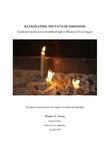Abstract
Light is seldom addressed in archaeological research, despite the fact that, at least in ancient Egypt, it would have impacted upon all aspects of life. When discussing light in Egyptology, the vast majority of scholarly attention is placed on the sun, the primary source of illumination. In comparison, artificial light receives very little attention, primarily due to a lack of archaeological evidence for lighting equipment prior to the 7th century BC. However, 19th and 20th century lychnological studies have exaggerated this point by placing an overwhelming emphasis on decorated lamps from the Greco-Roman Period. In an attempt to move beyond these antiquarian roots, recent scholarship has turned towards examining the role that light, both natural and artificial, played in aspects of ancient societies’ architecture, ideology and religion. The extensive body of archaeological, textual and iconographic evidence that remains from ancient Egypt is well suited to this type of study and forms three core data sets in this thesis. Combining a materials-based examination of artificial light with a contextualized, theoretical analysis contributes to a richer understanding of ancient Egyptian culture from the 3rd to 1st millennium BC. The first three chapters of this study establish a typology of known artificial lighting equipment, as well as a lexicon of lighting terminology. A comparison of the archaeological and textual evidence allows for a discussion on the consumption of lighting in ancient Egypt and its impact on social and economic spheres. From this material it becomes apparent that artificial light was a luxury and this corresponds to its inclusion in religious texts and iconography, as well as the presence of lighting implements in tombs of the wealthy elite. The second half of the thesis examines the ritual application of artificial light, incorporating iconographic and textual evidence, consideration of ritual space and timing, and experimental archaeology. This interdisciplinary approach allows for a discussion of the sensory experience of artificial lighting and its perceived potency in ancient Egypt. It also demonstrates the contribution that Egyptology can make to lychnological and sensory studies of the ancient Near East and Mediterranean by examining the impact of light on phenomenology and aesthetics.Keywords
ancient Egypt, Egyptology, artificial light, lychnology, light, night, darknessIdentifiers
This record's DOI:https://doi.org/10.17863/CAM.24194
Thursday, July 25, 2019
Illuminating the path of darkness: social and sacred power of artificial light in Pharaonic Period Egypt
Illuminating the path of darkness: social and sacred power of artificial light in Pharaonic Period Egypt
Subscribe to:
Post Comments (Atom)






No comments:
Post a Comment